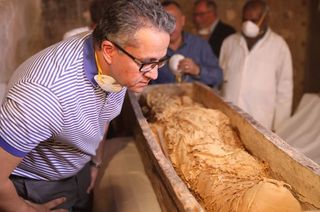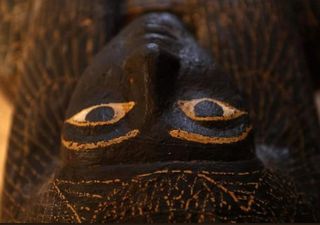Exquisitely Preserved Mummies Discovered in One of Egypt's Largest Tombs
In one of the largest tombs ever found in Luxor, Egypt, archaeologists have discovered a sarcophagus holding the mummy of a woman named Pouyou who lived during the 18th dynasty, the Egyptian Ministry of Antiquities announced on Nov 24.
In a nearby tomb, another team found several mummies inside sarcophagi with one sarcophagus having hieroglyphics that refer to the goddess Mut, the ministry reported.
Several confusing reports on the discovery over the weekend erroneously reported that all the mummies were found in a single tomb. [See Images of the Tombs, Mummies and Excavation at Luxor]
Mummy family?
Tomb TT33 — as archaeologists call one of the findings in Luxor (a city that was also called Thebes in ancient times) — is being excavated by a French team led by Frédéric Colin, an Egyptology professor at the University of Strasbourg in France. The tomb has been excavated several times since the 19th century, revealing many artifacts. Even so, the tomb is so big that parts of it are still unexcavated.

The new discoveries include the sarcophagus of Pouyou (also spelled Pouya), who lived sometime during the 18th dynasty (1550-1295 B.C.), said the French team in a statement. At that time, Egypt was independent and powerful, at times controlling an empire that stretched as far as modern-day Syria. Pouyou's sarcophagus was opened during a Nov. 24 press conference, revealing the remains of her mummy.
The tomb also yielded another sarcophagus, although it's not yet clear who it belongs to. Its painting and design indicate that it dates to the 17th dynasty (1580-1550 B.C.), the French team said in its statement. At that time, the Hyksos, a group from west Asia, controlled part of Egypt.
Additionally, the French team discovered several mummies in the tomb, outside of a sarcophagus. These mummies may be from the same family, the Egyptian ministry said in a series of tweets. It's not clear when this family lived or if Pouyou is related to them.
Sign up for the Live Science daily newsletter now
Get the world’s most fascinating discoveries delivered straight to your inbox.
Overseer of mummification
Researchers found several sarcophagi and mummies in the other Luxor tomb, this one called TT28 by archaeologists. An Egyptian team led by Mostafa Waziri, secretary general of the Supreme Council of Antiquities, is currently excavating this tomb. While archaeologists have known this tomb existed, much of it has never been scientifically excavated.

Hieroglyphs on one of the newly discovered sarcophagi indicate that the object belongs to "Thaw InkhetIf," who was the overseer of a mummification shrine located near Thebes, the Ministry of Antiquities said in a series of tweets as well as an Arabic-language statement.
The hieroglyphs indicate that InkhetIf held a number of titles and that the people who worked in his shrine worshipped the goddess Mut, the wife of the god Amun, the statement said. At times in Egypt's history, Amun was regarded as the most powerful god, with his cult based at Thebes.
Inside that tomb, archaeologists found more mummies and sarcophagi, as well the remains of about 1,000 "shabti" figurines, the ministry statement said. These objects were commonly buried in Egypt to serve the deceased in the afterlife.
Excavation of both tombs and analysis of their remains are ongoing.
- 24 Amazing Archaeological Discoveries
- 30 of the World's Most Valuable Treasures That Are Still Missing
- The 25 Most Mysterious Archaeological Finds on Earth
Originally published on Live Science.

Owen Jarus is a regular contributor to Live Science who writes about archaeology and humans' past. He has also written for The Independent (UK), The Canadian Press (CP) and The Associated Press (AP), among others. Owen has a bachelor of arts degree from the University of Toronto and a journalism degree from Ryerson University.
Most Popular

